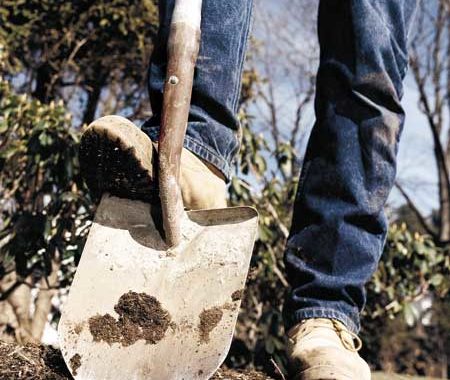HandShovels (Download)
Hand Shovels highfillperformancegroup.com 1 What is a Shovel Definition: – an implement consisting of a broad blade or scoop attached to a long handle, used for taking up, removing, or throwing loose matter, such as earth, snow, or coal. http://dictionary.reference.com/browse/shovel http://www.remlr.com/photos/CES/shoveltypes.jpg 2 History of Shovels Early shovels were discarded ox scapula (or shoulder blades). They were used to move soil and rocks in the Neolithic and Early Bronze Age Britain, over 5,000 years ago. Some of the earliest shovels put to use in construction , were implemented to move earth and to cut lumps of brick in order to build levees or dykes http://www2.umoncton.ca/cfdocs/etudacad/1755 3 Standard Usage of a Shovel A shovel is a tool used to move loose material on construction sites such as: – Gravel – Earth – Asphalt – Debris listentotheyeti.com 4 Safety Concerns The most common safety concerns with shovels are: – Back Problems – Self Lacerations – Blisters – Splinters – Coming into contact with utility lines (especially below ground) thewmpetconnection.com 5 How to Avoid Back Problems Workers should keep their feet well separated for good balance , always keeping their knees flexed . Use the proper type of shovel for the task: A. Short handle shovels are used for spreading or laying asphalt, dirt, etc. Hold this shovel with one hand close to the load for proper balance and to reduce stress on the worker ’ s back. B. Long handle, pointed shovels are used for digging. This shovel should also be held close to the load when carrying material. Workers should load their shovel sparingly on their first load and gradually increase the next load size until they reach the capacity, which they can handle in a safe and efficient manner. http://www.honolulu.gov/HR/safetytipsonshoveling.pdf 6 How to Avoid Back Problems Workers should bend their knees but not their backs while shoveling. Their knees should be flexed so that their leg muscles take most of the load. Workers should be keeping their arms and elbows close to their body while handling loads. This move will set worker ’ s bodies in balance and in a power position. Workers should never twist their body while spreading or laying asphalt, dirt, materials, etc. Twisting will only increase the risk of an injury. Workers should always turn their forward foot and body in the direction they will spread or lay the material. http://www.honolulu.gov/HR/safetytipsonshoveling.pdf 7 How to Avoid Foot Injury Workers should wear steel toed work shoes with sturdy soles. When digging, use the ball of the foot (not the arch) to press the shovel into dirt , asphalt, gravel, etc. If the instep/arch is used and the foot slips off the shovel, the sharp corner of the shovel may cut through the worker ’ s shoe and into their foot or leg. When shoveling wet, sticky or hard-packed materials, the worker should be sure to loosen the material before lifting the load . Do not jerk the load when lifting it. http://www.honolulu.gov/HR/safetytipsonshoveling.pdf 8 How to Avoid Blisters and Splinters When workers use shovels on construction sites they should be wearing gloves to ensure that their hands are protected. treehugger.com 9 How to Avoid Cutting Utilities Call before Digging: 811 (Free Service, will mark out utilities within 48 hours) Be sure to call no less than 2 days before, but no more than 5 days . This will reduce the risk of damaging the following utilities: Natural gas Electrical Water Wastewater service Telephone lines Cable television lines http://web.dcp.ufl.edu/hinze/Short-Talk-Call-Before-You-Dig.ppt brazosnet.com 10 OSHA Regulations Shovels are used regularly in the construction industry but are not specifically mentioned in the OSHA Regulations Although activities which involve the use of shovels (e.g. trench excavation etc.) are mentioned. osha.gov 11 Fatality Data There were 2 fatalities investigated by OSHA from 1990 thru 2009. “ Source: Extracted from OSHA Accident Investigation Data 1990-2009 ” 12 Fatality Examples 1) A worker was removing dirt with a shovel, while working behind a trencher. The shovel came in contact with the chain drive causing the handle to kick-back and hit the worker on the left side of his neck. He suffered a severed blow to the artery causing a blood clot. He was pronounced dead. 2) A worker was working on a roof directly below a 7200 volt overhead electrical line. He was using a fiberglass handled shovel to reach over the parapet and “pop ” a tile off the parapet. The metal end of the shovel apparently contacted the overhead electrical line during the work activity and he was electrocuted. “ Source: Extracted from OSHA Accident Investigation Data 1990-2009 ” 13 Best Practices Proper PPE is to worn including s teel toed boots with sturdy soles, Hard Hat, Glasses, Dust Mask and Gloves. Appropriate clothing should be worn such as long sleeves and long pants . Keep a minimum of 8 ft from others while shoveling to avoid injury, and keep a safe distance from machinery operating in the area. binbin.net guashan.com 14 Best Practices (Continued) Always load the shovel with adequate foot pressure, from the ball of the foot. Always inspect the handle to make sure it has no loose shards and is not cracked Also make sure that the handle attachment to the head is solid Always lift loaded shovel with the legs (not the back). saltandclay.org 15 Think Safety Work Safely 16

